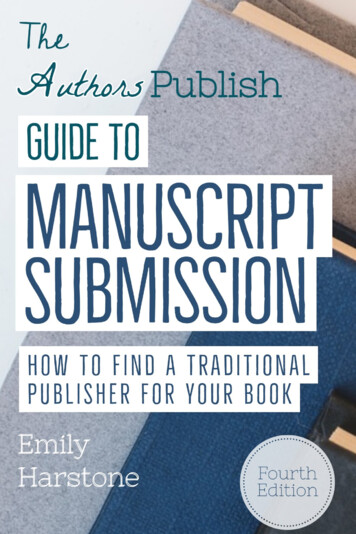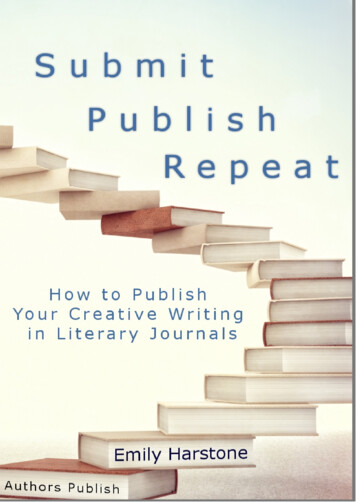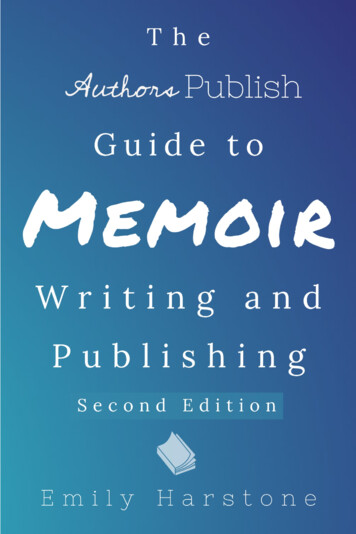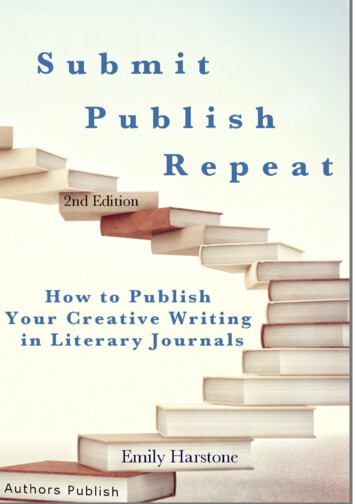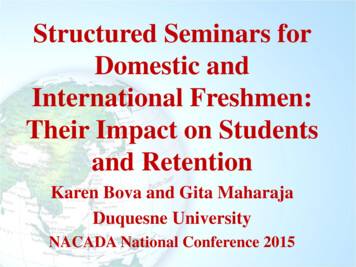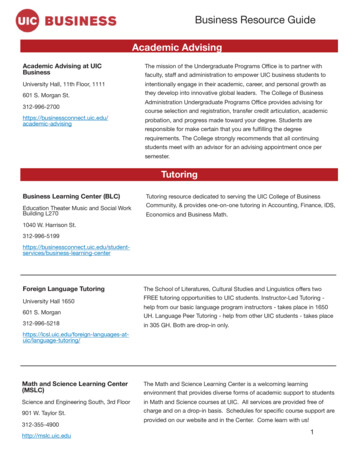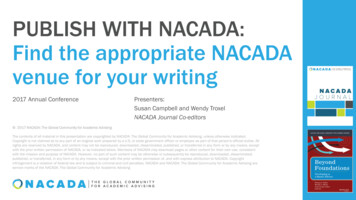
Transcription
PUBLISH WITH NACADA:Find the appropriate NACADAvenue for your writing2017 Annual ConferencePresenters:Susan Campbell and Wendy TroxelNACADA Journal Co-editors 2017 NACADA: The Global Community for Academic AdvisingThe contents of all material in this presentation are copyrighted by NACADA: The Global Community for Academic Advising, unless otherwise indicated.Copyright is not claimed as to any part of an original work prepared by a U.S. or state government officer or employee as part of that person's official duties. Allrights are reserved by NACADA, and content may not be reproduced, downloaded, disseminated, published, or transferred in any form or by any means, exceptwith the prior written permission of NACADA, or as indicated below. Members of NACADA may download pages or other content for their own use, consistentwith the mission and purpose of NACADA. However, no part of such content may be otherwise or subsequently be reproduced, downloaded, disseminated,published, or transferred, in any form or by any means, except with the prior written permission of, and with express attribution to NACADA. Copyrightinfringement is a violation of federal law and is subject to criminal and civil penalties. NACADA and NACADA: The Global Community for Academic Advising areservice marks of the NACADA: The Global Community for Academic Advising
240 members wrote for NACADA venues in 2016 NACADA Blog Academic Advising Today (AAT) NACADA book review The NACADA Journal NACADA books Clearinghouse of Academic Advising Resources
By the way . This presentation is available on the Writing for NACADA webpage,which also has lots of good stuff . RESOURCES WRITING FOR NACADA CADA.aspx
What we’ll talk about today Purpose Content Writing Guidelines Acceptance Process How do I get published ?
What would you like to contribute to our literature?Write down at least one idea youhave for writing about an advisingrelated issueand / ora question you have about writingfor NACADA.
The continuum of NACADA publicationoutletsBlogBook ReviewsAATStay tuned Journal
NACADA Publications PhilosophyResearch, theory, and practice Research Qualitative and quantitative research Humanities-based research Critical analysis Theory Applying existing theory to academic advising Developing new theory relevant to advising Advising Practice
ACADA.aspx
“Concise” NACADA Publication optionsSubmissions should be: About an advising/student success related NACADAexperience Educational in nature, positive in tone, & focused onparticular aspects of academic advising Original and written especially for the NACADA blog Both product- and vendor-neutral, and non-political
“Concise” NACADA Publication optionsWriting Guidelines To the point, roughly 400 words Use 1st person singular. Writing in a conversational tone engagesreaders; advisors like hearing personal stories. Bulleted format and urls when appropriate No peer review, minimal copy editing Images are effective! Contact nblog@ksu.edu
The continuum of NACADA around
NACADA Book ReviewOnline in Resources section of NACADAwebsite Review a current book (good place to start as a new author)Current members may review once each yearList of available books on web (see URL below)Become familiar with book review sections: Choose and request a book Write and submit the review E-letter sent to administrator of choice Published to spx Email: bookrev@ksu.edu
The continuum of NACADA aroundBook ReviewsJuried criticalreviewSignedcopyrightreleaseLetter to youradministrator
Quarterly electronic publication (e-pub) Juried by Editorial Team Blind review as needed Practical application of theory or research 1000-1500 words not counting reference citations APA (6th ed.) publication style preferred, MLA accepted(no footnotes)
Draft acceptance rate 60% Authors should seek primary editing assistance prior tosubmission. Final copy editing assistance is provided byRegan Baker. Submit your article via e-mail to Leigh Cunningham,Managing Editor, at Leigh@ksu.edu
The continuum of NACADA aroundBook ReviewsAATJuried criticalreviewSignedcopyrightreleaseFocused topicSignedcopyrightreleaseLetter to yourLetter toadministratoradministrator
In-Depth NACADA publication opportunities Pocket Guides Books/chapters Journal
Big news!! Coming in early 2018!! NACADA Review: Academic Advising Praxis and Perspectives Drs. Ruth Darling and Oscar van Den Wijngaard, Co-editors Longer than AAT, more “contextual” than most NACADAJournal articles Focused on high impact practices that are theoretically based Example: Institutional initiatives with “lessons learned” and“implications for others” Peer-reviewed, quicker turnaround
NACADA Review: Academic AdvisingPraxis and Perspectives. . . is a peer-reviewed, online academic journal which aims atconnecting the theory and practice of academic advising andrelated, relevant fields (such as teaching and learning,student development, pedagogy, developmental psychology)in a mutually reinforcing way.
The continuum of NACADA aroundBook ReviewsAATJuried ignedcopyrightLetter to your releaseadministratorLetter toadministratorNACADA ReviewScholarly andcontextual,withimplicationsfor practice
Journal Purpose Professional publicationo Blind-reviewedo Peer-refereed Published twice a year Scholarly articles on research,theory & practiceNACADA members receive a print copy. All articlescan be accessed at www.nacadajournal.org.Download the mobile app!TheNACADAJournalexists toadvancescholarlydiscourseabout theresearch,theory,andpractice ofacademicadvising inhighereducation.
Journal Guidelines Manuscripts should not exceed 6,000 words(excluding title page, abstract, and references) Most articles based upon IRB-approved research thatuses standard qualitative or quantitative researchmethodology, or humanities-based research, ortheoretical analysisAppropriateOriginal Journal and APA style guides able
Journal Review Process1. Co-Editors read each manuscript; determine readiness to goto Manuscript Reviewers Co-Editors work directly with authors if significant revision isneeded before blind review2. Three Manuscript Reviewers read article (no authoridentification) and write an independent review3. Co-Editors read reviews and re-read manuscript4. Co-Editors write an Editorial Decision Letter Decisions: Accept, Revise study/manuscript, Reject5. Approximately 30% of manuscripts are published
What happens after “revise and resubmit”? Author decides whether to revise and lets the editors know ofintent (author is given about 3 months to work on next draft)During that time the author carefully considers the feedback fromreviewers, reaches out to the co-editors and other critical friends,and re-writesManuscript is resubmitted, including a companion document thataddresses the revisions made (hint for success: directly address the reviewers’ suggestions)Revised manuscript goes back out to reviewersEditorial decision is madeShampoo, rinse, repeat
What happens after acceptance?Developmental copy editing process Authors sign copyright release to begin editing process Accepted manuscripts sent to Nancy Vesta, NACADA CopyEditor Edits Clarify meaning and eliminate jargon Check mechanics and APA compliance Check internal consistency of facts Editing process takes three months Author receives edited manuscript with queries whereneeded Authors return manuscript to Copy Editor within 10 days
Tips for getting article published in the NACADA Journal Become familiar with theNACADA Journal Proofread to assure you are reallyfinished Place article in the context ofprevious Journal articles onyour topic “Clean” manuscript for blind review;use cover sheet for identificationinformation If writing based upondissertation: follow chapter in5th edition of APA manual Learn from the review process;schedule time to revise and then do it! Follow all relevant guidelines(Journal web site, APA styleguide 6th edition) Include letter with revision detailinghow you addressed reviewercomments Sign copyright release to moveaccepted manuscript to copy editphase
And finally
Reviewer Opportunities What is reviewed? 1st drafts written for NACADA-produced books and Digest offerings NACADA books currently in print that are 6 years old Who reviews? Members knowledgeable on the topic Previous publishing experience is helpful but not required Currently under review: 2017 for Academic Advising Administration:Essential Knowledge and Skills for the 21st Century Complete application online to be considered.
How to get started Become familiar with venue guidelines Read, Read, Read! Invite collaborators/reviewers; brainstorm “wonderings” Set a time & place to write, and give yourself deadlines Review the Writing for NACADA website Write, proofread, and review with “critical friends” Revise based upon feedback and submit!
How do I find stuff?BlogOpinionswelcomedBook ReviewsJuried criticalreviewAATFocused,importanttopicsNACADA ReviewScholarly andcontextual,withimplicationsfor practiceJournal/BooksScholarlypublicationsAdds to theliterature
How do I find stuff?BlogOpinionswelcomedBook ReviewsJuried criticalreviewAATFocused,importanttopicsNACADA ReviewScholarly andcontextual,withimplicationsfor practiceJournal/BooksScholarlypublicationsAdds to theliterature
Repository of Valuable ResourcesBlogOpinionswelcomedBook ReviewsJuried criticalreviewAATFocused,importanttopicsNACADA ReviewScholarly andcontextual,withimplicationsfor practiceJournal/BooksScholarlypublicationsAdds to theliterature
POP QUIZ!! Where would you send a piece about an interesting andimportant opinion from your unique viewpoint? Where would you send an article based on your advisingexperience which could help others? Where would you send a scholarly article based onformal (IRB approved) inquiry or philosophical analysis? Where would you send an idea based on research ortheory that will improve academic advising practice?
What will you write? What topic? What venue? Final questions and comments?Questions when you get home?email publish@ksu.edu
Thank you for attending! Please completethe sessionevaluation
identification) and write an independent review 3. Co-Editors read reviews and re-read manuscript 4. Co-Editors write an Editorial Decision Letter Decisions: Accept, Revise study/manuscript,
